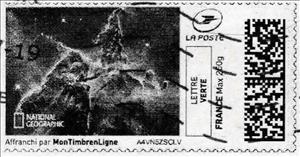Stamp: Pillars of Creation in black (France 2018)
Pillars of Creation in black (France 2018)
01 January (France ) within release MonTimbrEnLigne. National Geographic goes into circulation Stamp Pillars of Creation in black face value Lettre No Face Value
| Stamp Pillars of Creation in black in catalogues | |
|---|---|
| Colnect codes: | Col: FR-TIM 2018-209b |
Stamp is square format.
Also in the issue MonTimbrEnLigne. National Geographic:
- Stamp - Cycling in the Desert in black face value Ecopli;
- Stamp - Earth 4 in black face value Lettre;
- Stamp - Eiffel Tower 1 in black face value Lettre;
- Stamp - Mountain 2 in black face value Lettre;
- Stamp - Pillars of Creation in black face value Lettre;
- Stamp - Roofs of Bourgogne in black face value Lettre;
- Stamp - Statue of Liberty in black face value Lettre;
- Stamp - Easter Island Statue face value R1-AR;
|
Data entry completed
46%
|
|
|---|---|
| Stamp Pillars of Creation in black in digits | |
| Country: | France |
| Date: | 2018-01-01 |
| Emission: | Personalized - Official |
| Format: | Stamp |
| Face Value: | Lettre No Face Value |
Stamp Pillars of Creation in black it reflects the thematic directions:
Outer space (or simply space) is the expanse that exists beyond Earth's atmosphere and between celestial bodies. It contains ultra-low levels of particle densities, constituting a near-perfect vacuum of predominantly hydrogen and helium plasma, permeated by electromagnetic radiation, cosmic rays, neutrinos, magnetic fields and dust. The baseline temperature of outer space, as set by the background radiation from the Big Bang, is 2.7 kelvins (−270 °C; −455 °F)
A star is a luminous spheroid of plasma held together by self-gravity. The nearest star to Earth is the Sun. Many other stars are visible to the naked eye at night; their immense distances from Earth make them appear as fixed points of light. The most prominent stars have been categorised into constellations and asterisms, and many of the brightest stars have proper names. Astronomers have assembled star catalogues that identify the known stars and provide standardized stellar designations. The observable universe contains an estimated 1022 to 1024 stars. Only about 4,000 of these stars are visible to the naked eye—all within the Milky Way galaxy.


